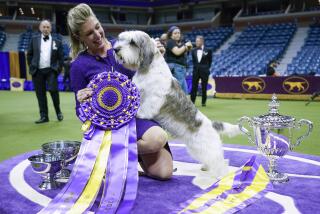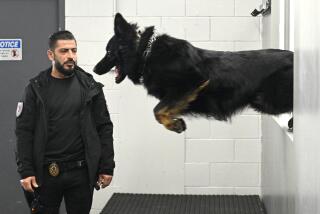Outdoors : GAME WINNERS : Gun Dog Showdown Tests Pointers, Flushers to Determine Hunter’s Best Friends
- Share via
If your dog won’t sit on command, can’t tell a quail from a cat and never points at anything but his food dish, he could have learned something at Norco last weekend.
Some of man’s more useful friends demonstrated their skills in that special partnership between hunter and dog. No snooty Westminster show this--prancing around an air-conditioned arena for a lousy blue ribbon. This was down in the dirt, find that bird, bring it back, food on the table and a pat on the head--all the reward in the world.
Good dog.
The Gun Dog Showdown at Raahauge’s hunting club was staged by the Quail Unlimited’s San Gabriel Valley chapter as a contest between flushers and pointers “to determine the best hunting dog in Southern California,” according to the billing.
Well . . .
That debate will rage forever but, to avoid further suspense, the winner and runners-up were, in order, pointer, pointer, flusher, flusher, pointer. Dog lovers can draw their own conclusions.
Jasper and his father, Herk, the first- and fifth-place finishers, are German shorthaired pointers who were run by Jim Collis, a professional dog trainer from Lake Mathews who seemed embarrassed that someone might think he was a ringer.
“I really don’t want to win,” he said. “I mean it.”
But his dogs couldn’t help themselves. Herk, his work done, would still be standing stone-still on point for an empty bird trap if Collis hadn’t physically pulled him away.
The best flushers, placing third and fourth overall, were Bob Sanchez’s little brown and white springer spaniel, Sam, and his Labrador retriever, Woody. Sanchez, who also has trained hunting dogs professionally, said it isn’t very difficult.
“You can train any dog to point,” he said. “A point is just a prelude to a jump . . . getting on the game. Generally, the Labs are the easiest. The pointers like to run and hunt, but the Labs want to please you more.”
Gary Langdon of Rialto, whose German shorthaired pointer, Bonnie, placed a close second to Collis’ Jasper, said: “These dogs are real easy to train. All you have to do is teach ‘em their name. They know more about hunting than we do.”
The contest would prove that point.
There were 42 entries, with two brushy fields 75 by 150 yards planted with one chukar partridge in each of three spring-loaded traps marked by colored stakes. A hunter had 10 minutes and five shells to bag the birds. Less time and unused shells were credited for points. Two judges graded the dog on efficiency, responsiveness to his handler and retrieving.
When the dog indicated he had located a bird, a nearby judge would release the trap remotely with a garage door-type control, the bird would be launched 10 feet into the air, and the hunter would try to shoot it.
From that simple format, it’s amazing how many things can go wrong. Take the springer named Jackson.
As Jackson’s handler snapped his fingers, the little dog broke like a shot, running at top speed back and forth across the field--”quartering,” it’s called--until it located the first trap and pounced. The bird sprang out, but it all happened so quickly that the handler couldn’t trip his safety before the bird was out of range.
Jackson also found the other two birds, but his handler missed.
“There’s a case of the dog doing an excellent job, but the handler was nervous,” said one judge, Mike Mathiot, who is Western Regional Director for Quail Unlimited. “That’s the best springer I’ve seen. That dog was red-hot.”
Another handler kept insisting his dog go one way--away from a bird--when the dog knew better. Even grabbed him and pushed him once.
“You never do that,” Mathiot said.
But the dogs are forgiving. Boone, a yellow Lab owned by Ray Chafe of Santa Ana, sniffed out all three birds in 3 minutes 46 seconds--fastest time of the day. When Chafe shot the birds, Boone picked them up and returned to sit quietly by Chafe’s left leg, bird in mouth.
But Chafe lost points because he took an extra shot at his first bird.
“Stupidity on my part, buddy,” he told Boone as they walked out of the field. “You did your part. I choked.”
Charlie Bittle of Midway City worked with Susie, a German shorthaired pointer who had trouble finding the downed birds.
“What is the matter with (her) today?” Bittle said in exasperation. “Usually she brings ‘em back to me on the run.”
Finally, Susie picked up a loose bird in the brush and struck a perfect point. The bird flushed, and Bittle knocked it down.
“If they’re there, my Susie will find ‘em, that’s for sure,” Bittle said.
Herk, rated a master hunting dog by American Kennel Club trial, is 8. Collis said a good dog can work until his teens.
“His father died at 15 and was hunting the year before,” Collis said.
Collis uses a whistle to get his dog’s attention, hand signals to direct him and, occasionally, verbal commands--”come around” to turn the dog, “whoa” to stop him. Most dogs don’t need to be told to keep moving, but some inexperienced dogs may wander aimlessly.
Not Herk. At a swing of Collis’ hand, he bounded into the field at a steady, purposeful lope, head up and all senses on full alert. From downwind, he locked in on the chukar scent from the first trap and came to a solid point 10 yards away. The bird sprang, Collis took deliberate aim, fired, and the bird fell. Herk hadn’t budged.
“Fetch,” Collis said, and Herk fetched.
After only 5 1/2 minutes, the game was over, but Herk wanted more. He struck a point at an empty trap, totally concentrated. A photographer walked all around Herk taking pictures. Herk didn’t even blink. The only thing moving was his bobbed, quivering tail.
Collis said: “He’ll stay there till the cows come home.”
The Gun Dog Showdown was less formal than an AKC field trial, and what was proved remained open to question--even to Collis, the winner. Is a pointer better than a flusher?
“That’s not a fair question,” Collis said. “It depends on what you want out of the dog.”
The dogs work differently, depending on a combination of instinct and training. Jerry Johnson of La Verne worked with Peg, a black Lab.
“A pointer, when he gets scent, will stay away from the bird . . . (and) usually lock up and go on point--actually put their nose down, bring their paw up, get their tail out,” Johnson said. “A Lab will come up, get the scent and they’re after ‘em. They push ‘em right out of the (cover).”
John Carnakis said: “A springer spaniel, as soon as the bird flushes, they’re taught to sit down. Then when the bird is shot, they have them go and retrieve on command.”
Collis said: “As a field dog, your pointing dog or your springer is probably a better dog than the Lab. The Lab is a good field dog and an outstanding water dog. When I go up north to Alturas for ducks, I take my Lab, because you’re talking zero to 32 degrees and times when the dog has to break ice to retrieve. These (pointers) can do it, but it’s really rough on their bodies. They don’t last as long as a Lab will.
“The springer is one of the best pheasant dogs. He can work the birds close and he’s fast. Bobwhite quail, you wouldn’t stand a chance. They’d push those birds out and you’d never get a shot. But a pheasant, he’ll get the pheasant between you and him, push it in to you. That’s an ideal springer, and most of them work that way.”
In this particular contest, before Jasper, a pointer, brought back three birds in 4 minutes 10 seconds, Collis said: “I would give the edge to the springer or the flushing dog because he puts the bird up instantly. The minute he gets near the bird, he puts it up, while we’re waiting for the dog to point it.
“Now, if you didn’t know where the marker was, I’d give the edge to the pointing dog. He’ll go out there and find it and he’ll stay there until you get within range. With a flushing dog, you might let him get a little far away and you might have a 60-yard shot instead of a 20-yard.
“My idea of an ideal pointer is a dog that will go out, find the bird, hold the bird, hold as the bird goes, you shoot, then you send the dog and he brings it back to your hand.”
Points weren’t deducted if a dog dropped a bird at a hunter’s feet.
“That’s hunter preference,” Collis said, “but I like ‘em to bring it back to the hand, because if the bird is (only) wounded and they drop it at your feet, as soon as the bird’s down, it’s gone.”
A good hunting dog will cost $250 to $300 as a puppy, then $200 to $300 a month to train, for a minimum of three months.
And if a hunter had to choose one all-purpose dog?
“First choice is German shorthaired,” Collis said. “Second choice is Lab. If I was just hunting duck, I’d use the Lab, but because I hunt quail, pheasant, chukar, dove and duck, I use the shorthair more than anything.”
Well, that settles it . . . or does it?


